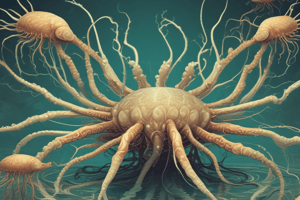Podcast
Questions and Answers
To what phylum does this organism belong?
To what phylum does this organism belong?
Cnidaria
Name the form that is free floating in organisms of this phylum.
Name the form that is free floating in organisms of this phylum.
Medusa
Name the form that is stationary and attached in organisms of this phylum.
Name the form that is stationary and attached in organisms of this phylum.
Polyp
Identify structure A.
Identify structure A.
Identify structure B.
Identify structure B.
Identify structure C.
Identify structure C.
Identify structure D.
Identify structure D.
Identify structure E.
Identify structure E.
Identify structure F.
Identify structure F.
Identify structure G.
Identify structure G.
Identify structure H.
Identify structure H.
Identify structure I.
Identify structure I.
Identify structure J.
Identify structure J.
Identify structure K.
Identify structure K.
Identify structure L.
Identify structure L.
Identify structure M.
Identify structure M.
Flashcards are hidden until you start studying
Study Notes
Cnidaria Phylum
- Includes diverse organisms such as hydras, jellyfish, and corals, characterized by their specialized cells called cnidocytes.
Medusa Form
- One of the two body forms in cnidarians that is free-floating; it resembles an umbrella shape and is typically associated with jellyfish.
Polyp Form
- The stationary and attached body form in cnidarians; it has a tubular shape and is often found in corals and sea anemones.
Tentacles
- Armed appendages that surround the mouth; used for capturing prey and defense.
Mouth/Anus
- A single opening in cnidarians that serves both feeding and waste expulsion.
Body Column
- The elongated, central part of the polyp that connects the tentacles to the basal disc.
Bud
- A reproductive structure that can develop into a new individual, found on the side of a polyp.
Basal Disc
- The structure that anchors the polyp to a substrate, allowing it to remain attached.
Mesoglea
- A jelly-like substance that separates the two cell layers (epidermis and gastrodermis) in cnidarians; provides support and buoyancy.
Gastrovascular Cavity
- A central cavity where digestion occurs; it transports nutrients throughout the organism.
Gastrodermis
- The inner layer of cells that lines the gastrovascular cavity, involved in digestion and nutrient absorption.
Epidermis
- The outer cell layer of cnidarians that provides protection and is involved in sensation.
Nutritive Muscular Cells
- Specialized cells in the gastrodermis that aid in digestion and help move food through the gastrovascular cavity.
Gland Cells
- Cells that secrete enzymes and substances aiding in digestion and other functions within the gastrovascular cavity.
Cnidocytes
- Specialized cells that contain nematocysts (stinging structures), used for capturing prey and defense against predators.
Studying That Suits You
Use AI to generate personalized quizzes and flashcards to suit your learning preferences.




